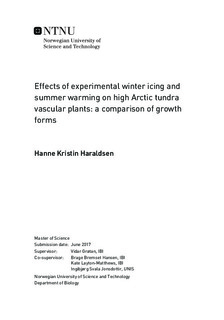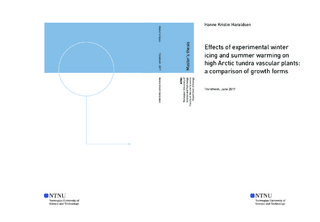| dc.description.abstract | No other place has experienced such pronounced changes in temperature and precipitation due to climate change, as the terrestrial Arctic. Ecological responses to warmer summers are already well documented, yet the responses to increasing winter temperature and precipitation, are far from understood. Precipitation combined with increased temperature, can result in solid ice layers on the ground, with impacts on plants and animals. Changed climate may cause changes in the plant community, if species respond differently. Understanding responses to changes in the climate and phenomena like rain on snow (ROS) are therefore needed.
I study responses in growth and flowering on plants in Adventdalen (78°N). To simulate the environmental effect of ROS events in winter, ice encasement on the ground was simulated during winter 2015/2016, and established open-top chambers increased the summer temperature (2016) with 0.85 °C and 0.98 °C, then inside control plot. I studied the impact of icing and summer warming treatments through a full factorial randomized block design (n= 36 plots, three blocks) on three key species, the perennial forb Bistorta vivipara and the grasses Poa arctica and Alopecurus borealis. Abundance, flower production, inflorescence height, leaf length, leaf weight, leaf width, surface area and specific leaf area were measured. Except for leaf width in B. vivipara, I found no evidence for interactions between icing and warming. Experimental icing increased the abundance of A. borealis significantly, had no effect on P. arctica, while B. vivipara decrease non-significantly. No icing effect was found on inflorescence height, but it decreased the total flower production. During the peak season, A. borealis leaves tended to be longer in icing plots, while icing did not affect leaf length and leaf weight of P. arctica. Icing had a positive effect on leaf width of B. vivipara (in reproductive type in plots with no summer warming), surface area and leaf weight. Summer warming resulted in increased abundance of both grasses, while B. vivipara abundance was unaffected. Summer warming also resulted in significant taller inflorescence of B. vivipara, greater P. arctica mass and showed a tendency for increased total flower production for the three species. This study show large variation among the species in their responses to experimental icing and summer warming. Although responses to icing and warming varied, even small changes in climate influence plant species. Still, climate change will likely be more pronounced in the long term, and affect other trophic levels. Knowledge about responses of key species are important to be able to predict how the ecosystem on Svalbard will respond to future climate change. | |

